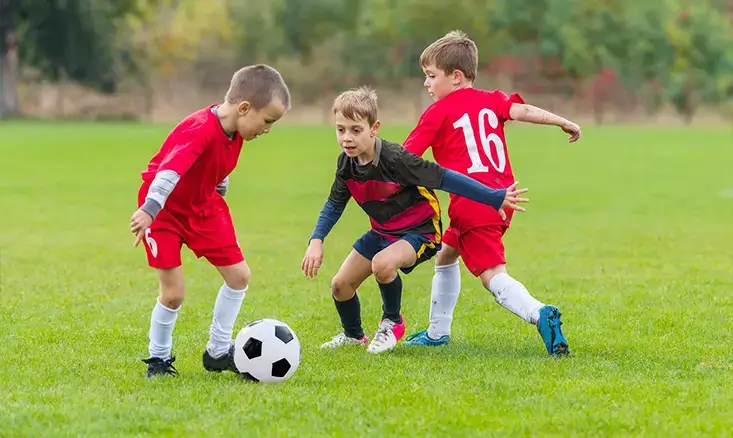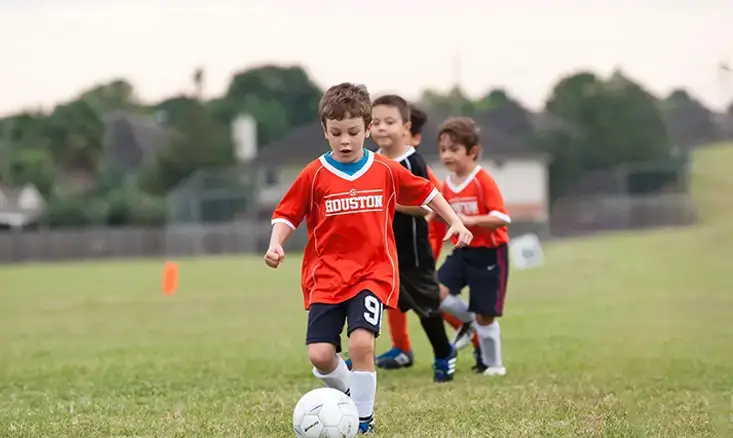CRFC BLOGS
LATEST BLOGS & NEWSLETTERS
Mastering Soccer Long Passing Drills: Essential Techniques for Youth Players Aged U5-U19
Long passing is a crucial skill in soccer. It enables teams to move the ball across the field quickly, switch the play, and create scoring opportunities. For young players, learning to execute long passes accurately and with control is essential for their overall development.
Understanding Long Passing in Soccer
A long pass in soccer involves kicking the ball over a greater distance, usually from one side of the field to the other or from the defense to the attack. Unlike short, quick passes used in tight spaces, long passes cover more ground and can break through defensive lines or switch the point of attack.
Understanding when and how to use long passes helps young soccer players develop their awareness of the game, their decision-making, and their ability to use the entire field. Learning the technique behind long passing is important, but it needs to be adjusted based on the player’s age and physical development.
Why Long Passing is Important for Youth Players
Long passing is important for youth players because it teaches them how to create space on the field and make smart decisions about when to switch the play or move the ball into open areas.
For younger players (U5-U9), the focus is on developing the foundational skills needed for all passing, such as coordination, ball control, and understanding direction. For older players (U10-U19), long passing drills become more essential as players develop the strength and understanding to execute more advanced passes.
Learning to deliver long passes accurately also helps players build teamwork, as they need to communicate with their teammates and understand their positioning on the field.
Key Skills Involved in Long Passing
-
Accuracy
A long pass should reach the intended teammate without being intercepted by an opponent. Teaching young players how to aim their passes correctly is critical.
-
Timing
Long passes are most effective when made at the right time, often when the opposing team is out of position. Older players (U10-U19) need to learn to read the game and make passes when the opportunity presents itself.
-
Control
Players must maintain control and not sacrifice accuracy for power, even when kicking the ball over a long distance.

The Fundamentals of Long-Distance Passing Drills for Youth Soccer
Long passing can be introduced gradually, with different types of passes and techniques being taught as players grow older. Here are some basic types of long passes:
Lofted Passes
This high, arcing pass travels through the air and is typically used to clear defenders or reach a teammate in open space. This technique is more suited to older youth players (U10-U19), requiring more strength and control.
Driven Passes
A driven pass is a lower, faster pass that moves quickly along the ground or just above it. This type of pass is useful for moving the ball across the field with speed and accuracy. Driven passes can be introduced to younger players as they begin to develop more power in their kicks (around U8-U9 and up).
For younger players (U5-U9), long passes should be taught using simplified techniques. Coaches can focus on developing basic passing mechanics, such as proper foot placement and follow-through, before introducing longer distances or higher kicks.
Improving Long-Range Passing Accuracy in Youth Soccer
Accuracy is one of the most important aspects of long passing. Here’s how to improve accuracy for different age groups:
U5-U9
Focus on shorter passes first. Have players aim for specific targets, like passing the ball between two cones or to a nearby teammate. This helps them learn control and precision before progressing to longer distances.
U10-U19
Players should practice long-distance passing drills by targeting more distant markers on the field. Coaches can set up cones or other markers at various distances and encourage players to hit the target while maintaining control. This helps them learn how to control the speed and direction of their passes.
Common Mistakes in Long Passing for Youth Players
-
Lack of Follow-Through
Younger players (U5-U9) often stop their leg motion too early, leading to weak or inaccurate passes. Encourage them to follow through completely with their leg after making contact with the ball.
-
Overuse of Power
Some players, especially in the U10-U19 age group, may try to kick the ball as hard as possible without focusing on accuracy. Remind them that controlled passes are more effective than overly powerful ones.
-
Misjudging the Ball’s Trajectory
Older players (U10-U19) may struggle with lofted passes, not judging how far or high the ball will travel. Practicing these types of passes consistently will help them develop better control over the ball’s flight.

Essential Youth Soccer Long Passing Drills
Here are some drills that are suited for youth soccer players of different age groups, from beginners to more advanced players.
Youth Soccer Long Passing Drills for Beginners (U5-U9)
1. Pass-and-Move Drill
This is a basic drill to teach young players how to pass the ball and move into space. Players pass the ball to a teammate, then move into a new position to receive the ball again. While this drill focuses on shorter passes, it builds the skills needed for longer passes later.
Why it’s effective
This drill helps players develop basic passing skills, movement, and decision-making.
Tip
For younger players, keep the distances short and focus on accuracy.
Long Ball Passing Youth Soccer Drills (U10-U19)
2. Cross-Field Passing Drill
For older players, this drill focuses on passing the ball across the field. Players stand on opposite sides of the field and practice sending long, accurate passes to each other.
Why it’s effective
It improves long-range passing and helps players understand how to switch the play during a game.
Tip
Encourage players to aim for specific targets or cones to improve accuracy.
Long-Range Passing Drills for Advanced Players (U12-U19)
Long Ball to Space Drill
In this drill, players practice passing the ball to teammates running into open space. This is a great way to develop the timing and power needed for long passes during real game situations.
Why it’s effective
It teaches players to read the game, anticipate their teammate’s movements, and deliver accurate long passes.
Tip
For U12-U19 players, introduce defenders to increase the challenge and simulate game-like pressure.
Position-Specific Long-Passing Drills
As players progress in their soccer development, long passing becomes an essential skill for specific positions:
Defenders
Defenders often need to clear the ball or make long passes to relieve pressure. In drills for defenders, focus on clearing long balls to midfielders or forwards.
Midfielders
Midfielders are key in transitioning the ball from defense to attack. Soccer midfield passing drills focus on long passes that switch the play or move the ball quickly up the field.
Goalkeepers
Goalkeepers can practice long passes or throws to start counter-attacks, helping them develop the skill of moving the ball quickly into the attacking third.
Tips for Coaching Long Passing in Youth Soccer
Start Simple
For younger players (U5-U9), begin with basic passing drills. As they get older and more skilled, introduce long passing drills.
Focus on Accuracy First
Whether it’s a short or long pass, accuracy is more important than power. Encourage players to focus on where they want the ball to go.
Incorporate Long Passing into Game-Like Drills
For older players (U10-U19), use drills that simulate real game situations, such as passing under pressure or to moving teammates.

Conclusion
Mastering long passing is an essential part of becoming a well-rounded soccer player. By practicing these youth soccer long passing drills regularly, players will develop the accuracy, timing, and decision-making needed to deliver effective long passes in games. For U5-U9 players, start with basic passing drills and build up to longer passes as they grow. For U10-U19 players, long passing drills should become a regular part of training to enhance their ability to switch play and create scoring opportunities.
FAQs
How Can I Teach My Child to Improve Their Long Passing Technique?
To help your child improve their long passing technique, focus on the fundamentals: proper foot positioning, a strong follow-through, and aiming for accuracy. Encourage them to practice kicking with the inside and laces of their foot for different types of long passes.
How Often Should Long Passing Drills Be Practiced?
Long passing drills should be practiced 2-3 times a week to help players develop strength and accuracy over time.
How Can Players Improve Accuracy in Long Passing?
Players can improve accuracy by focusing on controlled movements, aiming for specific targets, and practicing regularly.
What’s the Difference Between Lofted and Driven Passes?
A lofted pass is a high, arcing pass, while a driven pass is lower and faster. Both types of passes are important for players to learn.
Should Goalkeepers Practice Long Passing?
Yes! Goalkeepers should practice long passing as it helps them start counter-attacks and clear the ball from danger.

Did you find this useful?


